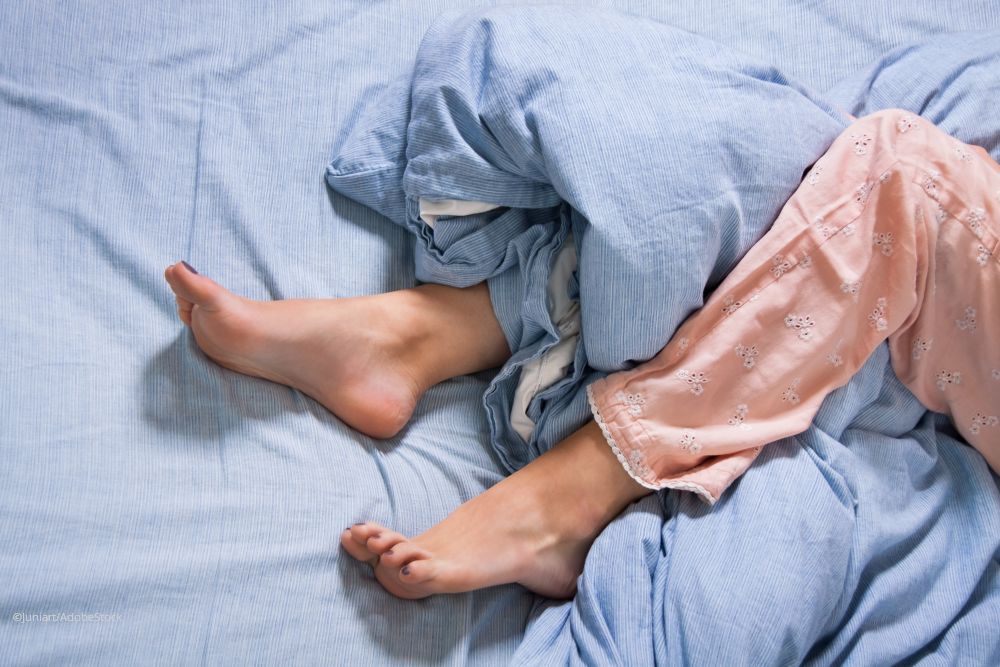Article
Vegan With Itchy, Creeping Sensations in Her Legs
Author(s):
Could the patient's symptoms be linked to her diet?
Image ©Juniart/AdobeStock

CHALLENGING CASE
A 40-year-old woman reports unpleasant sensations in both legs and an overwhelming compulsion to move them. She describes an itchy, creeping sensation deep within the muscles. The sensation worsens when she sits at her desk or watches TV-and especially when she lies in bed at night. Walking or shaking her legs partially relieves the discomfort, but it returns when she rests again.
She says that the leg symptoms have worsened to the point that they interrupt her sleep. She feels sleepy during the day, which is interfering with her performance at work.
History
In the past, she had similar episodes, which occurred intermittently starting at age 36. At that time, she was in graduate school and the episodes occurred only when she was very tired. Over the past 6 months, the episodes have worsened so that they now occur every night.
Of note, she became a vegan 6 months earlier in an attempt to live a healthier lifestyle. She has lost 10 lb, which she attributes to the new diet.
When she was younger and played sports, she sometimes developed muscle cramps when she became dehydrated. She describes the current problem as distinctly different. She denies numbness in her legs.
She is not currently taking any medications. Because of her vegan diet, she takes a B complex vitamin supplement daily.
Past medical history is notable for borderline mild anemia and fibroids, which sometimes cause heavy bleeding during menstruation. Her mother suffers from depression and has had similar episodes but has not received a diagnosis. Her maternal grandfather has Parkinson disease.
Physical examination
Temperature is 98.6°F (36.9°C); pulse, 80 beats/min; respirations, 20 breaths/min; blood pressure, 115/70 mm Hg; body mass index, 24. The patient is in no acute distress. Results of abdominal, cardiac, and respiratory examinations are unremarkable.
Neurological examination
Cranial nerves are grossly intact; strength is 5/5 throughout; tone is within normal limits; reflexes are 2+ symmetric with downgoing plantar reflex; sensation is intact to sharp and dull throughout. Coordination and gait are normal. No tremor is appreciated.
Mini-Mental State Examination (MMSE) is within normal limits. The patient denies symptoms of depression, anxiety, or suicidal ideation.
Laboratory studies
Complete metabolic panel, blood glucose level, complete urinalysis with reflex microscopy, thyroid-stimulating hormone level, and vitamin B12 and folate levels are within normal limits; human chorionic gonadotropin test is negative for pregnancy.
Complete blood cell count is notable for hematocrit of 30% (normal, 34%-45%); platelets, 150 x 103 cells/µL (normal, 150-400 x 103 cells/µL); hemoglobin, 9.0 g/dL (normal, 11.2-15.7 g/dL); red blood cell count, 3.45 x 106 cells/µL (normal, 3.90-5.2 x 106 cells/µL); red blood cell distribution width-coefficient variation, 30.3 g/dL (normal, 32.0-36.0 g/dL); red blood cell distribution width-standard deviation, 48.1 fL (normal, 36.4-46.3 fL), and mean corpuscular volume, 30.3 g/dL (normal, 32-36 g/dL).
Serum iron level is 40 µg/dL (normal, 60-140 µg/dL); total iron-binding capacity, 500 µg/dL (normal, 250-450 µg/dL); transferrin saturation, 10% (normal, 20%-50%); and ferritin, 10 ng/mL (normal, 30-300 ng/mL).
DIAGNOSIS: Primary restless legs syndrome
The patient meets all criteria for a diagnosis of primary restless legs syndrome (RLS)1:
• Urge to move legs usually accompanied by uncomfortable or unpleasant sensation in the legs
• Urge to move legs accompanied by unpleasant sensations that begin or worsen while at rest
• Urge to move legs accompanied by an unpleasant sensation partially or totally relieved by movement
• Urge to move legs with an unpleasant sensation during rest or inactivity that happens or worsens in the evening or night
History, physical examination, and laboratory results rule out secondary causes of RLS: renal disease, Parkinson disease, neuropathy, venous stasis, arthritis, leg cramps, peripheral neuropathy, pregnancy, and mood and anxiety disorders.
Clinical course
Because the patient’s condition is likely exacerbated by iron-deficiency anemia caused by her vegan diet, oral iron sulfate 100 mg twice daily is prescribed, along with docusate (Colace). Her symptoms gradually improve over the next month.
Because heavy bleeding from fibroids can contribute to her anemia, she is referred to an obstetrician-gynecologist for further workup.
Discussion
Underlying brain iron deficiency is thought to play a role in the pathogenesis of primary RLS, although the exact mechanism is unknown. Current guidelines from the American Academy of Neurology recommend treating RLS when it interferes with sleep and daily functioning. Because iron deficiency can contribute to RLS, anemia should be treated first before starting other agents.2
Yet not much research backs up this recommendation. A 2012 Cochrane review concluded that insufficient evidence supports the treatment of RLS with iron.3 A 2017 evidence-based review found that oral iron does not benefit patients with RLS who do not have iron deficiency, and its benefits in people with RLS and iron-deficiency anemia have not been adequately studied.4
However, most recently a meta-analysis of ten trials published between 2004 and 2018 and covering 455 patients suggested that 4 weeks of iron supplementation was connected to significantly improved restless leg symptoms, sleep quality, and quality of life.5 The trial could not determine optimal dosages for oral and intravenous iron, or optimal duration of therapy.
References:
1. International Restless Legs Syndrome Study Group. Diagnostic criteria. http://irlssg.org/diagnostic-criteria/ Accessed March 14, 2019.
2. American Academy of Neurology. Practice guidelines: treatment of restless legs syndrome in adults. https://www.aan.com/Guidelines/home/GetGuidelineContent/831 Accessed March 14, 2019
3. Trotti M, Bhadriraju S, Becker LA. Iron for restless legs syndrome. Cochrane Database Syst Rev. 2012;5:CD007834.
4. Winkelmann J, Allen RP, Högl B, et al. Treatment of restless legs syndrome: evidence-based review and implications for clinical practice (revised 2017). Mov Disord. 2018;33:1077-1091. doi: 10.1002/mds.27260.
5. Avni T, Reich S, Lev N, et al. Iron supplementation for restless legs syndrome - a systematic review and meta-analysis. Eur J Intern Med. 2019 Feb 21. pii: S0953-6205(19)30053-6. doi: 10.1016/j.ejim.2019.02.009.


